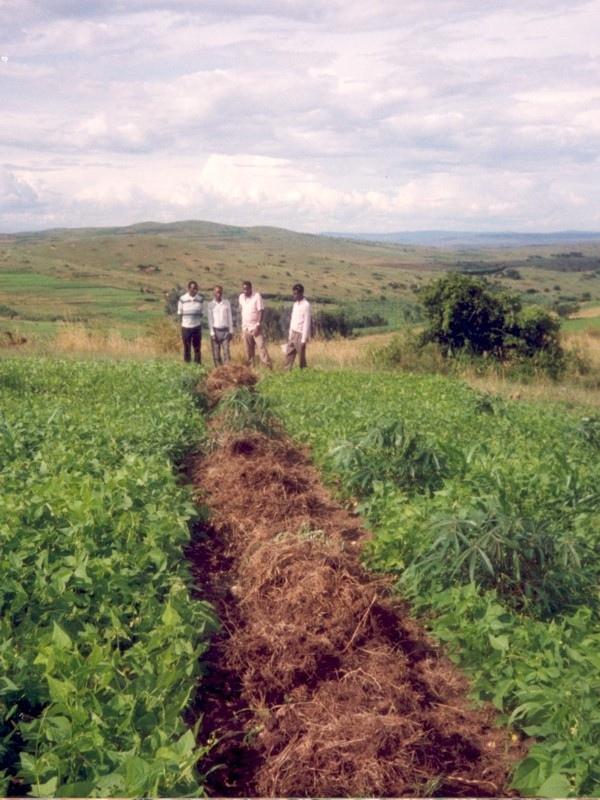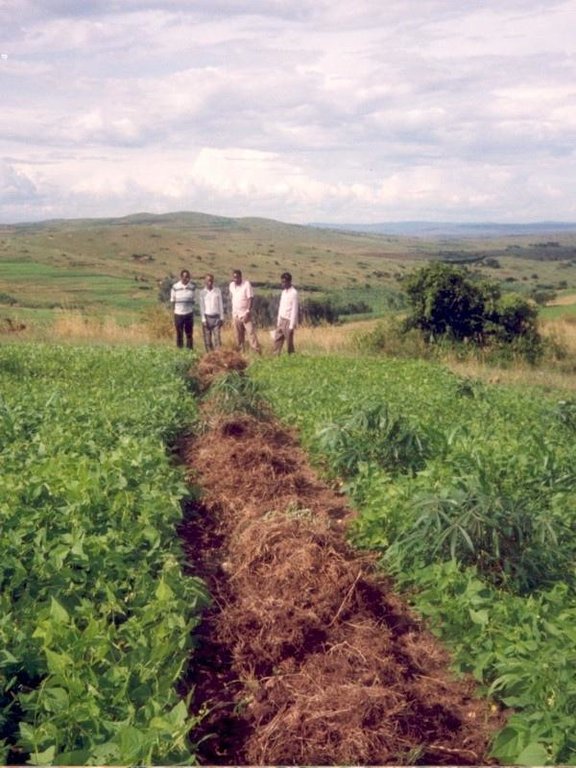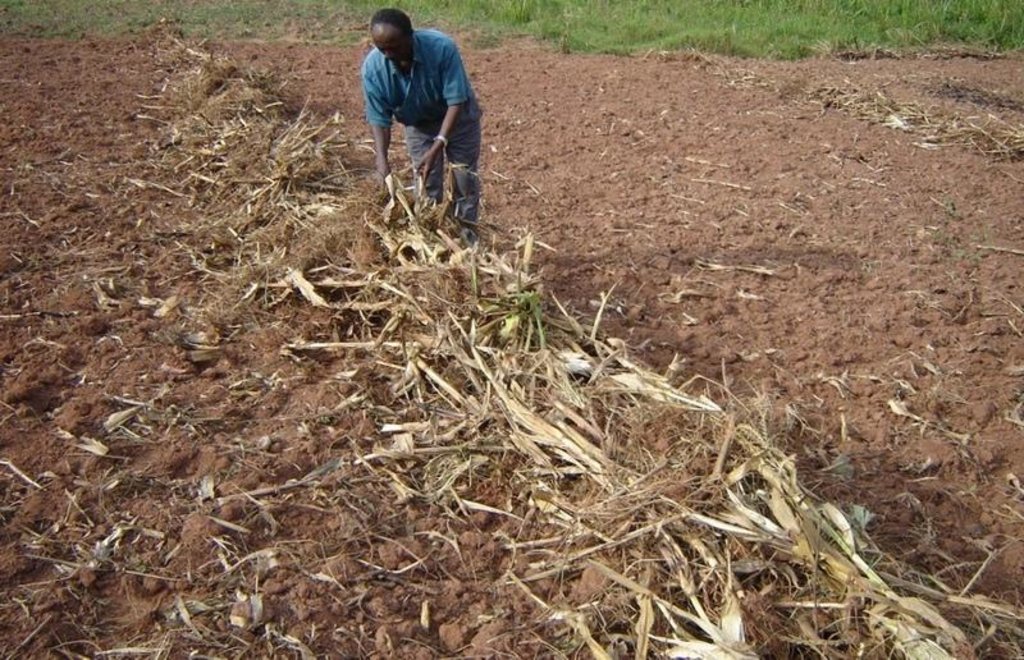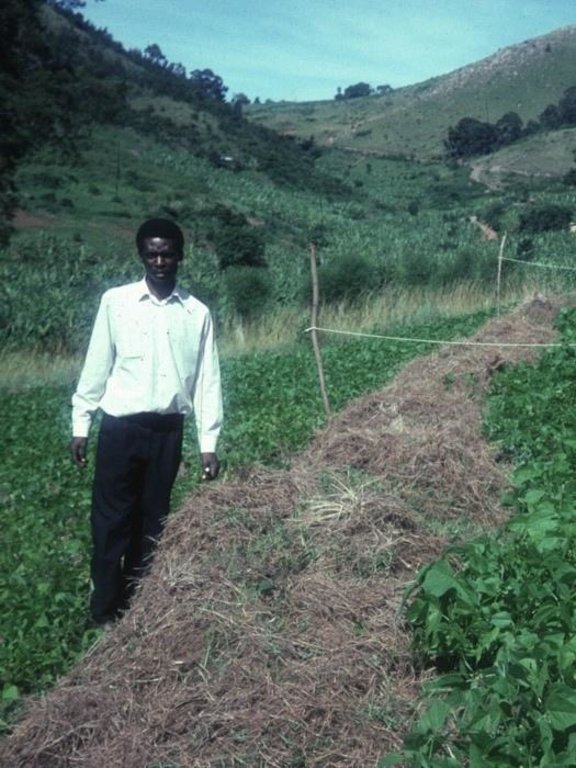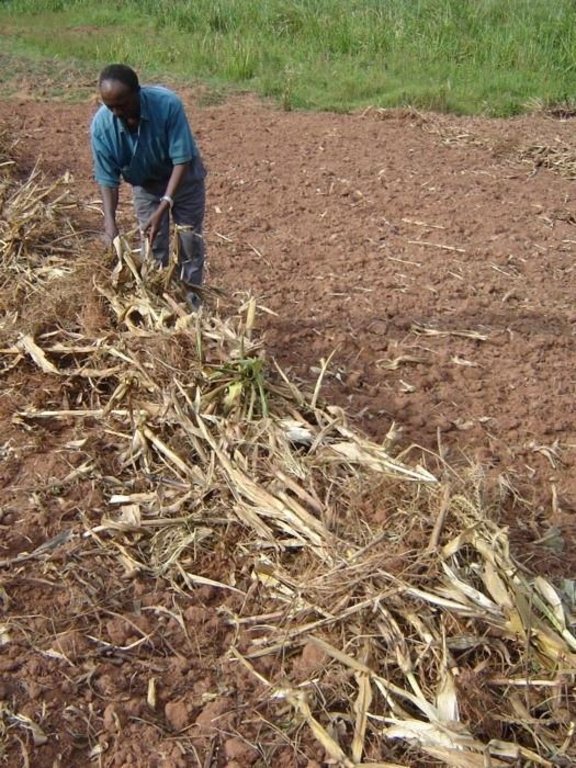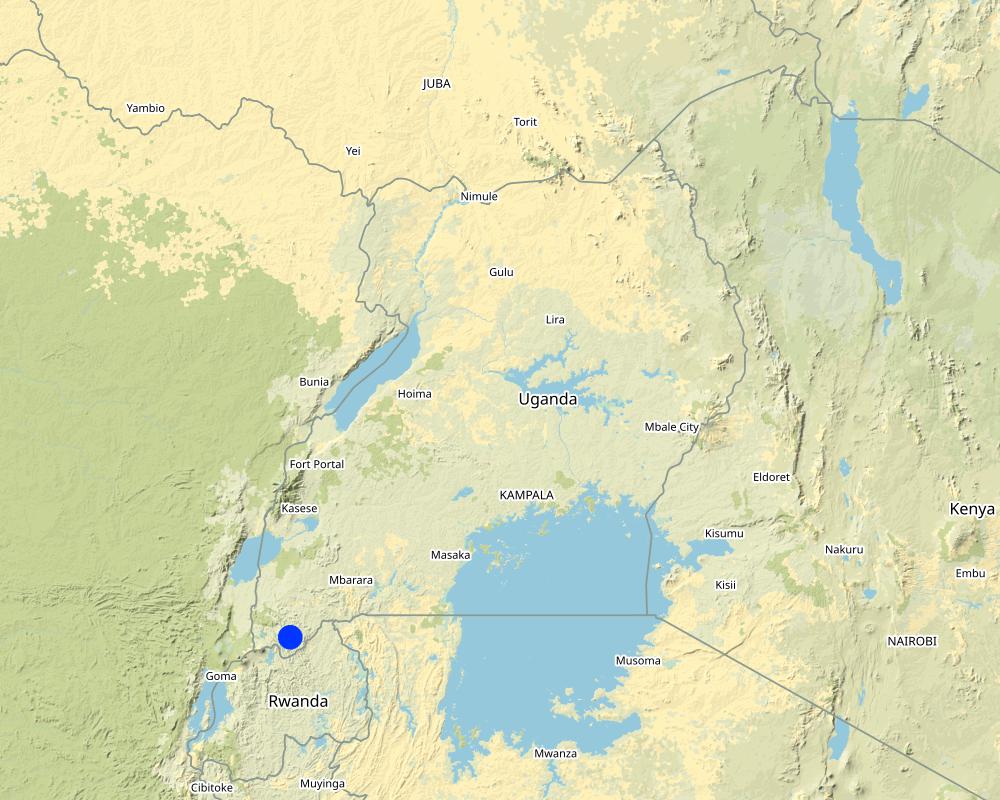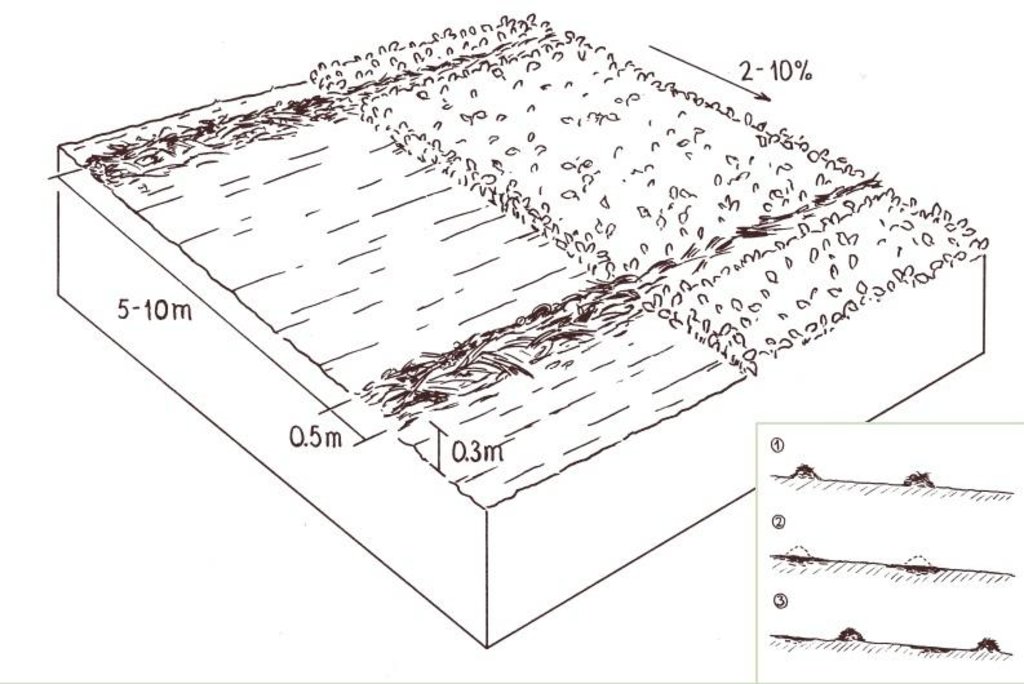Improved trash lines [乌干达]
- 创建:
- 更新:
- 编制者: Unknown User
- 编辑者: –
- 审查者: Alexandra Gavilano, Fabian Ottiger, Joana Eichenberger
Emikikizo (Lukiga)
technologies_990 - 乌干达
查看章节
全部展开 全部收起1. 一般信息
1.2 参与该技术评估和文件编制的资源人员和机构的联系方式
关键资源人
SLM专业人员:
Miiro Henry Dan
Ministry of agriculture animal industry and fisheries - Uganda
乌干达
有助于对技术进行记录/评估的项目名称(如相关)
Book project: where the land is greener - Case Studies and Analysis of Soil and Water Conservation Initiatives Worldwide (where the land is greener)有助于对技术进行记录/评估的机构名称(如相关)
Ministry of agriculture, animal industry and fisheries (MAAIF) - 乌干达1.3 关于使用通过WOCAT记录的数据的条件
编制者和关键资源人员接受有关使用通过WOCAT记录数据的条件。:
是
1.5 参考关于SLM方法(使用WOCAT记录的SLM方法)的调查问卷
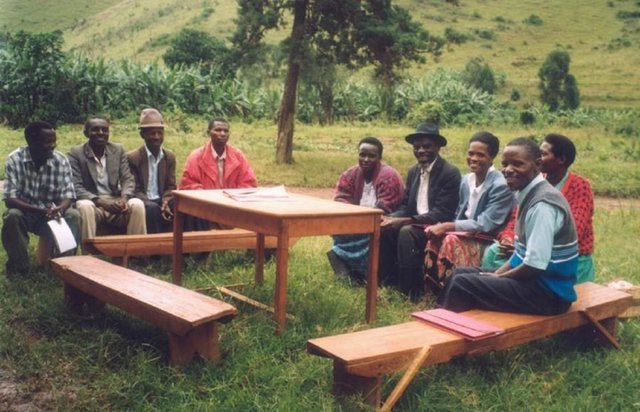
Promoting farmer innovation [乌干达]
Identification of farmer innovators in SWC and water harvesting, and using them as focal points for visits from other farmers to spread the practices and stimulate the process of innovation.
- 编制者: Kithinji Mutunga
2. SLM技术的说明
2.1 技术简介
技术定义:
Weeds and crop residues laid in bands across the slope of annual crop fields to conserve soil and water, and to incorporate organic matter into the soil after decomposition.
2.2 技术的详细说明
说明:
Trash lines of organic material across the slope constitute a traditional land husbandry practice in south-west Uganda. These traditional, ‘unimproved’, trash lines are beneficial, but even better is an improved version designed through Participatory Technology Development (PTD). Improved trash lines are smaller, closer spaced, and of longer duration than the traditional type. They are more effective in controlling runoff and maintaining soil fertility.
All trash lines (improved and traditional) are composed of cereal stover (straw) and weeds that are collected during primary cultivation (hand hoeing), and heaped in strips along the approximate contour. Creeping grasses should not be used in trash lines: they can alternatively be decomposed in bundles, and then used as mulch in nearby banana plantations. Trash lines are used in hillside fields where annual crops, including sorghum, finger millet, beans and peas, are grown. The recommended spacing between the improved trash lines is 5-10 m, depending
on the slope: the steeper the closer. The amount of material available determines the cross section of each trash line (typically ±0.5 m wide and ±0.3 m high). Improved trash lines are left in place for four seasons (there are two seasons a year in Kabale) before they are dug into the soil. Much of the material used has, by this time, decomposed or been eaten by termites. Through incorporation into the topsoil, they improve soil fertility acting effectively as ‘mobile compost strips’. New trash lines are then established between the sites of the former lines. Upkeep comprises removal of weeds that sprout within the lines - before they set seed - and the addition of more trash during each new cultivation and weeding cycle.
Improved trash lines are multipurpose in retarding dispersed runoff while, as discussed, maintaining soil fertility. They are a low-cost option for soil and water conservation. However, they need to be complemented by other measures on the steeper slopes. The climate in this part of Uganda is subhumid, with a bimodal rainfall regime, and average annual rainfall of around 800 mm. Hill tops are used for grazing, the lower slopes are cultivated with annual crops (where the trash lines are found) and the valleys are dedicated to bananas and other cash crops. Families are large: 8-10 persons, and the population density is high, at nearly 200 persons/km2.
2.3 技术照片
2.5 已应用该技术的、本评估所涵盖的国家/地区/地点
国家:
乌干达
区域/州/省:
Kabale
有关地点的进一步说明:
Kabale district
具体说明该技术的分布:
- 均匀地分布在一个区域
如果不知道精确的区域,请注明大致覆盖的区域:
- 0.1-1 平方千米
注释:
Total area covered by the SLM Technology is 0.25 km2.
it is an indeginous technology. Widely used in various fields and at different slopes.
Map
×2.6 实施日期
如果不知道确切的年份,请说明大概的日期:
- 50多年前(传统)
2.7 技术介绍
详细说明该技术是如何引入的:
- 作为传统系统的一部分(> 50 年)
3. SLM技术的分类
3.1 该技术的主要目的
- 改良生产
- 减少、预防、恢复土地退化
- 适应气候变化/极端天气及其影响
3.2 应用该技术的当前土地利用类型

农田
- 一年一作
- 多年一作(非木材)
- 乔木与灌木的种植
年作 - 具体指明作物:
- 谷类 - 小米
- 谷类 - 高粱
- 豆科牧草和豆类 - 豆子
- 豆科牧草和豆类 - 豌豆
多年生(非木质)作物 - 指定作物:
- 香蕉/芭蕉/蕉麻
- Eucalyptus
每年的生长季节数:
- 2
具体说明:
Longest growing period in days: 180 Longest growing period from month to month: Feb - Jul Second longest growing period in days: 120 Second longest growing period from month to month: Sep - Jan
注释:
Major land use problems (compiler’s opinion): Continuous cultivation of annual crops on slopes prone to erosion, with little or no restitution of fertility through manures
or fertilizers.
Major land use problems (land users’ perception): continous cultivation without fallow due to small sizes of farms
3.4 供水
该技术所应用土地的供水:
- 雨养
3.5 该技术所属的SLM组
- 改良的地面/植被覆盖
- 横坡措施
- 集水
3.6 包含该技术的可持续土地管理措施
3.7 该技术强调的主要土地退化类型

土壤水蚀
- Wt:表土流失/地表侵蚀

化学性土壤退化
- Cn:肥力下降和有机质含量下降(非侵蚀所致)

水质恶化
- Ha:干旱化
注释:
Main type of degradation addressed: Wt: loss of topsoil / surface erosion, Cn: fertility decline and reduced organic matter content
Main causes of degradation: other human induced causes (specify) (lack of communication), education, access to knowledge and support services (lack of spread of knowledge)
3.8 防止、减少或恢复土地退化
具体数量名该技术与土地退化有关的目标:
- 防止土地退化
- 减少土地退化
注释:
Main goals: mitigation / reduction of land degradation
Secondary goals: prevention of land degradation
4. 技术规范、实施活动、投入和成本
4.1 该技术的技术图纸
技术规范(与技术图纸相关):
Trash lines without crops (left)
and with crops (beans; right).
The insert shows the stages of the technology: regularly spaced trash lines are kept place for four seasons (1); then decompose over time and are incorporated into the soil (2); and finally new trash lines are placed between the previous strips (3).
Technical knowledge required for field staff / advisors: low
Technical knowledge required for land users: low
Main technical functions: control of dispersed runoff: impede / retard, increase of infiltration, increase in soil fertility
Secondary technical functions: control of dispersed runoff: retain / trap, increase in organic matter, improvement of soil structure, sediment harvesting
Agronomic measure: mulching, trash lines
Material/ species: weed residue, sorghum
Remarks: along contour
作者:
Mats Gurtner
4.2 有关投入和成本计算的一般信息
其它/国家货币(具体说明):
Uganda Shillings
如相关,注明美元与当地货币的汇率(例如1美元=79.9巴西雷亚尔):1美元=:
1000.0
注明雇用劳工的每日平均工资成本:
1.00
4.4 技术建立所需要的费用和投入
| 对投入进行具体说明 | 单位 | 数量 | 单位成本 | 每项投入的总成本 | 土地使用者承担的成本% | |
|---|---|---|---|---|---|---|
| 劳动力 | Labour | ha | 1.0 | 25.0 | 25.0 | 100.0 |
| 设备 | Tools | ha | 1.0 | 5.0 | 5.0 | 100.0 |
| 技术建立所需总成本 | 30.0 | |||||
| 技术建立总成本,美元 | 0.03 | |||||
注释:
Duration of establishment phase: 36 month(s)
4.5 维护/经常性活动
| 活动 | 时间/频率 | |
|---|---|---|
| 1. | During land cultivation, existing (old) trash lines are dug. 2. New trash lines are then created exactly between the (cross-slope) | Dry season / each cropping season |
| 2. | The size of the trash lines depends on the amount of trash available, | Dry season |
| 3. | Weeds are added to the trash lines, and, in preparation for the second | Second season |
| 4. | Trash lines are kept free of growing weeds and built up with more | Third and fourth seasons |
| 5. | Trash lines are kept free of growing weeds and built up with moretrash. Full cycle for improved trash lines: 4 seasons (2 years) |
4.6 维护/经常性活动所需要的费用和投入(每年)
注释:
Machinery/ tools: hand hoe
These figures are approximate, representing a typical situation with 1,500 running metres of improved trash lines, per hectare, at a spacing of 7 m apart on a 10% slope. The 1st year (first and second seasons) involves more work than the
2nd year (third and fourth seasons): the figure given is an annual average of all work associated with trash lines. The costs of the traditional, larger and wider spaced trash lines are about 50% more than these given above - because trash has to be carried further.
4.7 影响成本的最重要因素
描述影响成本的最决定性因素:
Labour, need to collect and heap the trashlines material in lines above the slope
5. 自然和人文环境
5.1 气候
年降雨量
- < 250毫米
- 251-500毫米
- 501-750毫米
- 751-1,000毫米
- 1,001-1,500毫米
- 1,501-2,000毫米
- 2,001-3,000毫米
- 3,001-4,000毫米
- > 4,000毫米
指定年平均降雨量(若已知),单位为mm:
800.00
农业气候带
- 半湿润
Thermal climate class: tropics
5.2 地形
平均坡度:
- 水平(0-2%)
- 缓降(3-5%)
- 平缓(6-10%)
- 滚坡(11-15%)
- 崎岖(16-30%)
- 陡峭(31-60%)
- 非常陡峭(>60%)
地形:
- 高原/平原
- 山脊
- 山坡
- 山地斜坡
- 麓坡
- 谷底
垂直分布带:
- 0-100 m a.s.l.
- 101-500 m a.s.l.
- 501-1,000 m a.s.l.
- 1,001-1,500 m a.s.l.
- 1,501-2,000 m a.s.l.
- 2,001-2,500 m a.s.l.
- 2,501-3,000 m a.s.l.
- 3,001-4,000 m a.s.l.
- > 4,000 m a.s.l.
关于地形的注释和进一步规范:
Slopes on average: Also rolling and hilling (both ranked 2)
5.3 土壤
平均土层深度:
- 非常浅(0-20厘米)
- 浅(21-50厘米)
- 中等深度(51-80厘米)
- 深(81-120厘米)
- 非常深(> 120厘米)
土壤质地(表土):
- 中粒(壤土、粉土)
表土有机质:
- 中(1-3%)
- 低(<1%)
如有可能,附上完整的土壤描述或具体说明可用的信息,例如土壤类型、土壤酸碱度、阳离子交换能力、氮、盐度等。:
Soil texture: Medium (the trash material modifies the organic matter content of the areas applied)
Soil fertility: Medium (ranked 1) and low (ranked 2)
Soil drainage/infiltration: Medium
Soil water storage capacity: Low (ranked 1) and medium (ranked 2)
5.6 应用该技术的土地使用者的特征
生产系统的市场定位:
- 生计(自给)
- 混合(生计/商业)
非农收入:
- 收入的10-50%
相对财富水平:
- 贫瘠
- 平均水平
机械化水平:
- 手工作业
说明土地使用者的其他有关特征:
1% of the land users are very rich and own 5% of the land.
5% of the land users are rich and own 10% of the land.
24% of the land users are average wealthy and own 50% of the land.
55% of the land users are poor and own 25% of the land.
Off-farm income specification: some farmers are involved in trade with nearby Rwanda and there are also a number of families who receive remittances from family members who work in Kabale or as far away as Kampala
5.7 应用该技术的土地使用者使用的平均土地面积
- < 0.5 公顷
- 0.5-1 公顷
- 1-2 公顷
- 2-5公顷
- 5-15公顷
- 15-50公顷
- 50-100公顷
- 100-500公顷
- 500-1,000公顷
- 1,000-10,000公顷
- > 10,000公顷
注释:
Average area of land owned or leased by land users applying the Technology: Also 1-2 ha (ranked 2) and 2-5 ha (ranked 3)
5.8 土地所有权、土地使用权和水使用权
土地所有权:
- 个人,未命名
土地使用权:
- 社区(有组织)
- 个人
6. 影响和结论性说明
6.4 成本效益分析
技术收益与技术维护成本/经常性成本相比如何(从土地使用者的角度看)?
短期回报:
积极
长期回报:
非常积极
6.5 技术采用
注释:
30 land user families have adopted the Technology without any external material support
Comments on spontaneous adoption: estimates
There is a moderate trend towards spontaneous adoption of the Technology
Comments on adoption trend: the technology is indeginous. There is some evidence of growing spontaneous adoption.
6.7 该技术的优点/长处/机会
| 土地使用者眼中的长处/优势/机会 |
|---|
|
Improved trash lines have small but significant advantages over the traditional trash lines (which are beneficial themselves) in terms of (a) less labour (b) improved crop performance How can they be sustained / enhanced? Continue with farmer-to-farmer visits for this to be explained. |
| 编制者或其他关键资源人员认为的长处/优势/机会 |
|---|
|
The technology is very simple and uses locally available material. It is easy to understand, being a modification of an existing tradition How can they be sustained / enhanced? Continue with farmer-to-farmer visits for first hand learning. |
|
Multiple ecological and SWC benefits: improves soil fertility, reduces erosion, increases infiltration etc How can they be sustained / enhanced? Continue to encourage adoption of (and further farmer experimentation with) the improved trash lines. |
6.8 技术的弱点/缺点/风险及其克服方法
| 土地使用者认为的弱点/缺点/风险 | 如何克服它们? |
|---|---|
| Source of weeds | Pull out weeds before they set seed and don’t use stoloniferous or rhizome-forming (creeping) grasses in trash lines (see picture). |
| trash line harbours pest and diseases | use entirely dry grass or material |
| 编制者或其他关键资源人员认为的弱点/缺点/风险 | 如何克服它们? |
|---|---|
| Where land is limiting, agricultural land which would be used, is lost | uses it as a crop rotation basis |
| The trash lines are not enough on their own to control erosion on the steeper slopes | Introduce/promote supplementary structural remedies such as earth bunds. |
| Competition for crop residues which have an alternative use as livestock fodder and, especially, mulch in banana plantations | Grow hedgerows of shrubs/grasses to increase availability of material for fodder, trash lines and mulching. |
7. 参考和链接
7.1 信息的方法/来源
7.2 参考可用出版物
标题、作者、年份、ISBN:
Briggs SR et al. Livelihoods in Kamwezi, Kabale District, Uganda.. 1998.
可以从哪里获得?成本如何?
Silsoe Research Institute, UK
标题、作者、年份、ISBN:
Mutunga K and Critchley W. Farmer’s initiatives in land husbandry Technical Report No 27. 2001.
可以从哪里获得?成本如何?
Regional Land Management Unit, Nairobi, Kenya
标题、作者、年份、ISBN:
Critchley W and Mutunga K .Local innovation in a global context: documenting farmer initiatives in land husbandry through WOCAT Land Degradation and Development (14) pp 143–162. 2003.
链接和模块
全部展开 全部收起链接

Promoting farmer innovation [乌干达]
Identification of farmer innovators in SWC and water harvesting, and using them as focal points for visits from other farmers to spread the practices and stimulate the process of innovation.
- 编制者: Kithinji Mutunga
模块
无模块


